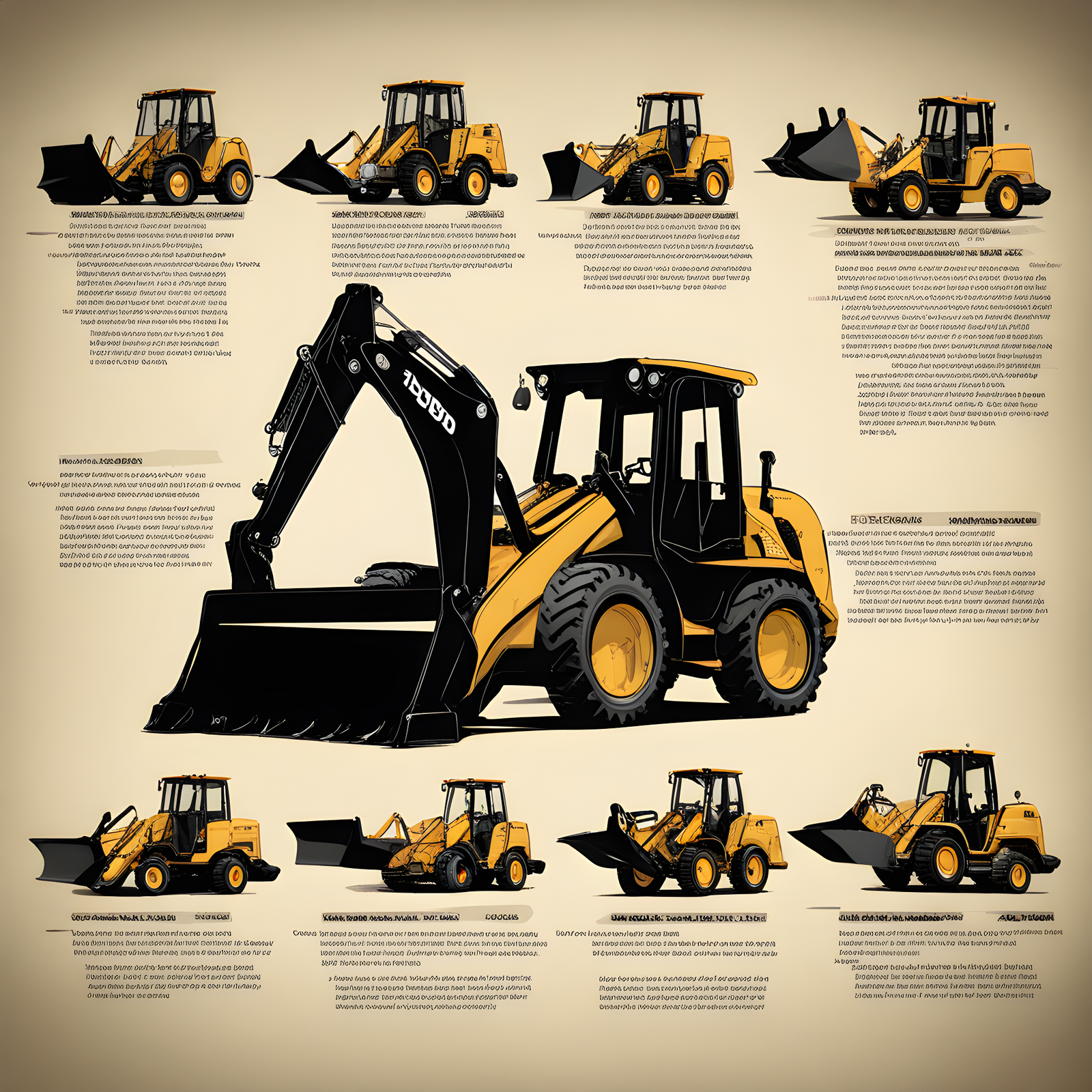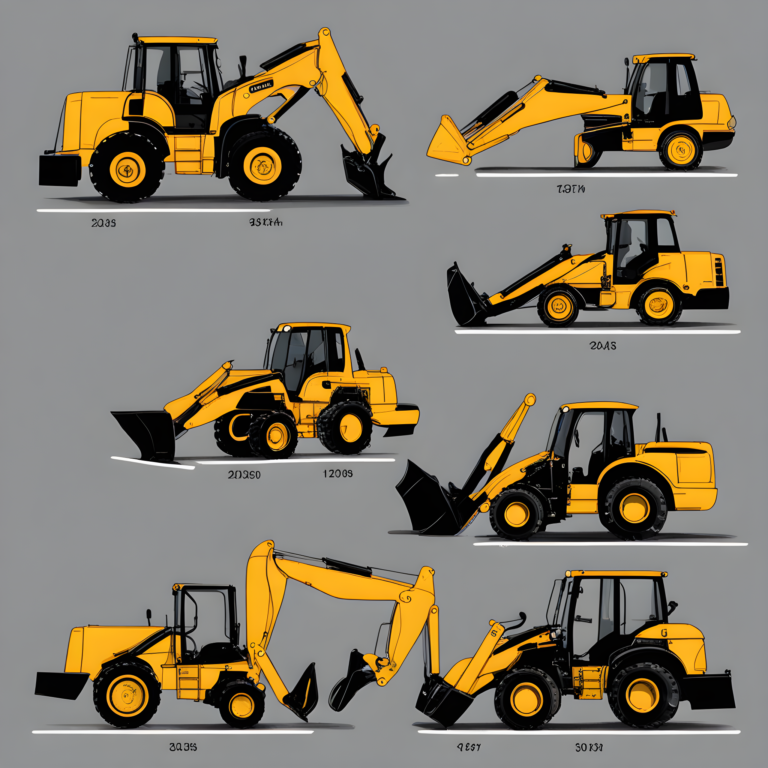The History of JCB: From Garage Startup to Global Giant

Table of Contents
INTRODUCTION
The term JCB immediately inspires respect and reputation when it comes to construction and agricultural machines. The history of JCB is more than simply the tale of a business; it’s also a tale of ingenuity, grit, and a constant quest for perfection in the field of heavy equipment production.
The company’s founder, Joseph Cyril Bamford, began by welding the first agricultural trailer together in a tiny garage in England in 1945, marking the beginning of JCB’s humble origins. This modest beginning created the groundwork for an empire that would transform the building and agriculture industries.
Over the years, JCB has introduced ground-breaking innovations including the first backhoe loader in the globe in 1953, which revolutionized the way excavation work was carried out all over the world. Telehandlers, tracked excavators, and compact machines furthered the company’s dedication to innovation and cemented its reputation for pushing limits.
With the help of its global expansion, JCB established a presence in more than 150 nations and supplied the machinery for crucial infrastructure projects all over the world. In addition to growing, JCB welcomed technical progress, introducing automation and digitalization into their machinery to improve productivity and safety.
JCB is distinguished by its unwavering commitment to sustainability, its pursuit of ecological design, lower emissions and energy-efficient operation. In today’s world, JCB is a global industry leader that sets the standard for heavy equipment manufacturing, drives development and continues to shape the future of construction and agriculture. The history of JCB is demonstration of the constant spirit of innovation and quality that characterizes this extraordinary firm.

The Early Days: A Humble Beginning
The Birth of JCB: Joseph Cyril Bamford's Vision (1945)
The history of JCB finds its roots in the transformative year of 1945 when Joseph Cyril Bamford, a visionary engineer and inventor, took the bold step of founding what would become a titan in the world of heavy equipment manufacturing. However, the genesis of JCB was far from a tale of grand corporate offices and opulent beginnings. Instead, it was a story that unfolded in the modest environs of a small garage situated in Uttoxeter, Staffordshire, England. This unassuming inception is emblematic of the very spirit that would propel JCB to greatness—a spirit characterized by pioneering innovation, tenacity, and a relentless pursuit of excellence.
The History of JCB in a Garage:
The garage startup of JCB serves as a poignant symbol of the company’s extraordinary odyssey. It marks the humble origins of an entity that would ascend to global prominence. Within the confines of that unpretentious garage, Joseph Cyril Bamford embarked on a mission to redefine the construction and agriculture machinery landscape.
Overcoming Initial Challenges:
Starting a business in a post-World War II Britain that was dealing with resource shortages and economic instability was no easy task. The driving element, though, was Bamford’s constant commitment to creating novel solutions for the construction sector. Manufacturing agricultural trailers, which were in great demand during the post-war reconstruction period, was his first big success.
Resilience Amidst Adversity:
The early challenges faced by JCB epitomize the resilience and creativity that would become integral to its storied success. These challenges were not stumbling blocks but stepping stones, shaping JCB’s identity as a company that thrives on adversity, ultimately emerging stronger and more innovative with each obstacle overcome.
In sum, the history of JCB is a testament to the power of vision, determination, and adaptability. It is a saga that inspires, reminding us that even from the humblest of beginnings, greatness can be forged through unwavering commitment to innovation and a relentless pursuit of excellence.

The Birth of the First Backhoe Loader
Innovation That Shaped an Industry
A significant accomplishment made by JCB in 1953 would permanently change the construction sector. The JCB Mark I, the first backhoe loader, was introduced to the globe in this year. This ground-breaking device integrated the capabilities of an excavator, loader, and tractor into a single, portable equipment.
The Revolution of the Backhoe A turning point in the history of JCB and the construction industry as a whole was the development of the backhoe loader. It signaled the beginning of a transformational period in which effectiveness and adaptability would take center stage.
Revolutionizing Construction
The backhoe loader had a significant influence on the building sector. It accelerated job completion, made construction considerably simpler, and reduced labor expenses. The JCB backhoe loader allowed operators to dig, load, and transfer materials effectively without having to employ several other machines on the building site. This flexibility improved the financial viability of construction projects while also saving time and resources.
The Backhoe Loader's Legacy
The backhoe loader’s versatility and efficiency set a new standard for the construction industry, cementing JCB’s reputation as an industry innovator. Its legacy endures as JCB continues to push the boundaries of heavy equipment manufacturing, leading the way in developing machines that redefine what’s possible in construction and agriculture. The JCB backhoe loader remains a symbol of the company’s commitment to innovation and its enduring impact on the construction world.
Expansion and Growth
The 1950s and 1960s
The 1950s and 1960s were incredibly important years for the history of jcb. They were all about striving for perfection and being pioneers in innovation. JCB didn’t stop pushing the limits of heavy equipment manufacturing during this time, and they introduced some truly game-changing products that left a lasting impact on the industry. Two standout machines from that period were the JCB 4C backhoe loader and the JCB 7 crawler loader. These were famous for being tough, dependable, and easy to use. They didn’t just meet the changing needs of construction and agriculture; they went above and beyond, setting new standards in the field.
Decades of Innovation
The 1950s and 1960s witnessed JCB’s unwavering dedication to product development. This commitment not only solidified its position as an industry leader but also set the stage for future successes, as the company’s reputation for quality and innovation continued to grow.
Establishing a Global Presence
As JCB’s reputation and product portfolio expanded, so did its international footprint. The company began exporting its equipment to various countries, effectively establishing a foothold in global markets. This period also marked a significant milestone with the opening of JCB’s first overseas manufacturing plant in India in 1979. This strategic move exemplified JCB’s commitment to global expansion and its vision of becoming a truly international heavy equipment manufacturer.
Global Reach
The development of JCB into a leading company in its field was greatly backed by its strategic approach to worldwide requests. By fusing invention with a significant global footmark, JCB was suitable to continue to shape and impact the construction and agrarian diligence encyclopedically, leaving an enduring imprint on the geography of the sector. The history of growth, invention, and worldwide reach left by JCB moment bears substantiation to its unvarying fidelity to excellence, showcasing the history of JCB’s commitment to excellence.
The History of JCB: The 1970s Boom

Meeting the Surge in Demand
The 1970s proved to be a vital decade for the history of jcb, characterized by a remarkable swell in demand for backhoe payload. Feting the burgeoning requirements of the construction assiduity, JCB fleetly responded by ramping up product and introducing a range of new models. This dexterity and capability to acclimatize to evolving assiduity trends set JCB piecemeal and made it the favored choice for contractors and builders worldwide. The company’s commitment to quality and invention continued to drive its success during this period.
A Decade of Growth
The 1970s marked a period of exponential growth for JCB, firmly establishing its dominance in the construction equipment market and contributing significantly to the history of jcb. Its backhoe loaders became synonymous with versatility, efficiency, and reliability, and the brand’s reputation for excellence spread far and wide.
International Expansion
Spreading Across the Globe
JCB’s journey from a garage startup to a global industry giant was marked by a deliberate and strategic approach to international expansion, an essential part of the history of JCB. The company made determined efforts to establish its presence in regions and countries around the world. This involved understanding local market dynamics and tailoring its products to meet regional requirements, further solidifying JCB’s reputation as a brand that could be trusted in diverse construction equipment markets.
Global Footprint
JCB’s unvarying commitment to transnational growth converted it into a truly global brand, honored and admired in different requests. The 1970s not only witnessed JCB’s remarkable response to request demands but also marked the morning of the history of jcb’s extensive global trip, setting the stage for its uninterrupted success on a worldwide scale.
Innovative Technologies and Product Lines
The Fastrac Tractor
In the world of husbandry, JCB made a significant impact with the preface of the JCB Fastrac tractor in the early 1990s. The Fastrac was nothing short of a disclosure. It seamlessly combined the power and performance of a traditional tractor with the speed and dexterity of a ultramodern vehicle, setting new norms in the agrarian sector. This innovative machine allowed growers to cover further ground in lower time, adding effectiveness and productivity in husbandry operations. The Fastrac’s influence transcended the agrarian geography, illustrating JCB’s capability to introduce beyond the realm of construction outfit.




Teleskid: Redefining the Skid Steer Loader
JCB’s penchant for innovation extended beyond backhoe loaders and tractors. In 2017, the company introduced the Teleskid, a groundbreaking machine that redefined the skid steer loader category. With a telescopic boom, the Teleskid combined the compactness of a skid steer with the extended reach of a telehandler. This fusion of versatility and reach made the Teleskid a game-changer in multiple industries, from construction to agriculture and beyond. It enabled operators to tackle a wider range of tasks with a single, agile machine, further solidifying JCB’s reputation as an industry innovator.
Commitment to Sustainability
Environmental Stewardship
JCB has long recognized the importance of sustainability and environmental stewardship. The company integrated eco-friendly practices into its operations by developing machines that met stringent emissions standards and prioritized fuel efficiency. JCB’s commitment to recycling and reducing waste also led to sustainable manufacturing processes, minimizing its environmental footprint. By embracing green initiatives, JCB demonstrated its responsibility towards the environment and future generations, aligning its values with global efforts to combat climate change and protect natural resources, thus becoming an essential part of the history of JCB.
A Global Giant Today
Leading the Industry
Moment, JCB stands as a global mammoth in the construction and agrarian outfit assiduity. Its product portfolio includes an expansive range of ministry, from excavators and telehandlers to compact track payload and creators. JCB’s unvarying commitment to quality, invention, and client satisfaction has earned it a strong character worldwide. It continues to lead the assiduity by setting the bar for excellence in heavy outfit manufacturing, contributing significantly to the history of JCB.
A Legacy of Excellence
JCB’s enduring heritage as a global assiduity leader is a testament to its unvarying commitment to excellence. Its success is erected upon a foundation of invention, rigidity, and a client- centric approach. From its groundbreaking machines to its sustainable practices, JCB has constantly pushed the boundaries of what is possible, shaping the future of construction and husbandry, and making an indelible mark on the history of JCB.
Recent Developments and Achievements
Expanding Sustainability: Electric and Hybrid Machinery
In response to the global emphasis on sustainability, JCB has expanded its product offerings to include electric and hybrid machinery. These eco-friendly solutions not only reduce emissions but also enhance job site conditions by minimizing noise pollution, contributing to a more harmonious and environmentally conscious work environment.
Reducing Emissions
JCB’s electric and hybrid machines are designed to significantly reduce carbon emissions, aligning with stringent environmental goals and regulations. These innovations reflect JCB’s commitment to a greener and more sustainable future.
Quieter Job Sites
The electric and hybrid equipment not only reduces emissions but also contributes to quieter and more pleasant job sites, benefiting both equipment operators and the surrounding communities. This aligns with JCB’s holistic approach to sustainability, which considers not only environmental but also social factors.
Digital Technologies and Telematics: Enhancing Efficiency
JCB has invested substantially in digital technologies and telematics, transforming the way heavy equipment is utilized and maintained.
Real-time Monitoring
Telematics systems enable real-time monitoring of machine performance, providing valuable data on usage, fuel consumption, and maintenance needs. This data-driven approach empowers operators and fleet managers with insights to make informed decisions.
Predictive Maintenance
By analyzing data from telematics, JCB can predict maintenance requirements, minimizing downtime and optimizing operational efficiency. This proactive approach ensures that equipment stays in peak working condition, reducing operational disruptions.
Cost Savings
Customers benefit not only from increased machine uptime but also lower maintenance costs, ultimately improving productivity and profitability. This cost-effectiveness aligns with JCB’s dedication to providing value to its customers.
Staying Ahead of the Curve
JCB’s commitment to innovation ensures it remains at the forefront of the construction and agricultural equipment industry.
Adapting to Evolving Needs
JCB continually adapts its offerings to meet the evolving needs of its customers and changing industry dynamics. Whether it’s through eco-friendly solutions or advanced telematics, JCB remains responsive to industry trends.
A Reliable Partner
By embracing sustainability and cutting-edge technology, JCB solidifies its reputation as a reliable and forward-thinking partner for businesses and industries worldwide. It exemplifies a commitment not only to its own success but also to the success of its customers.
Driving Positive Change
JCB’s dedication to innovation positions it as a driving force for positive change in these vital industries. It leads the way toward a sustainable and technologically advanced future, where heavy equipment plays a central role in building a better world.
Conclusion
In conclusion, “The History of JCB” is a captivating journey through the annals of innovation, vision, and unwavering determination. From its humble beginnings in a garage to its current standing as a global industrial giant, JCB’s story is a testament to what can be achieved when ambition and commitment to excellence converge.
JCB’s history is not merely a chronicle of corporate success; it is a profound narrative that resonates with the essence of human potential. The company’s ascent is marked by its continuous drive to redefine the boundaries of heavy equipment manufacturing. With each stride forward, JCB has introduced cutting-edge technologies and a forward-looking ethos that has not only shaped its industry but has also had a far-reaching impact on the world at large.
Throughout its storied history, JCB has exemplified the transformative power of innovation and sustainability. It is a beacon of progress, illuminating the path to a brighter future. In every challenging terrain, whether literal or metaphorical, JCB has shown that the route to progress is paved with innovation and an unyielding commitment to excellence.
JCB’s history serves as a source of inspiration for society as a whole as well as for people working in the business. It acts as a reminder that achieving perfection is a worthwhile endeavor rather than just an ideal to aspire to. The legacy of JCB goes well beyond the walls of its offices and factories; it touches the very core of human inventiveness.
JCB’s history serves as a monument to the resilient human spirit in a world faced with difficult difficulties and unpredictabilities. It emphasizes the significant influence one business may have on a whole sector of the economy and, consequently, the entire planet. “The History of JCB” is a story about tenacity, flexibility, and a never-ending search for a better future. It serves as a reminder that progress will continue to be made and new chapters in the history of JCB will be added as long as there are pioneers ready to push the envelope.
Disclaimer: AI-Generated Imaginary Photos The images in this blog post are entirely AI-generated and do not represent reality. They are for creative purposes only and should not be considered real. Any resemblance to actual people or places is coincidental.
